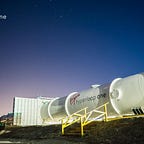Hyperloop Could Be Europe’s New Unifying Force
The world’s fastest transport system would give a hyper boost to economic growth and revitalize European integration.
By Risto Penttilä, CEO, FInland Chamber of Commerce, and Secretary General, European Business Leaders’ Convention
The biggest change Europe faces may not be Brexit or President Trump. It may well be an unexpected disruption in the world’s transport systems. Hyperloop is faster than a plane. It produces no emissions. It carries both cargo and people through air-evacuated tubes. And it is about to take off. A couple of months ago I went to Nevada to see first-hand Hyperloop One’s half-kilometer test track, which is gearing up to begin public trials in the coming months. The plan is to have three cargo or passenger systems in service by 2021.
Hyperloop One is unveiling its Vision for Europe at an event today in Amsterdam, which I’m joining as an interested observer and commentator. My hope for the transportation future is to see Hyperloop connect my home region, the Nordic capitals, with the heart of Europe. It starts from Helsinki, dives under the Gulf of Finland to Tallinn, continues along the Baltic Rail corridor all the way to Berlin. From Berlin, the “Circle Line” continues to Copenhagen. From Copenhagen, Hyperloop makes a 60-second sprint to Malmö and splits into two routes. One goes to Oslo while the other heads for Stockholm, reachable in 45 minutes. If you want to ride the whole Circle, you continue another half an hour to Helsinki.
The result is a New Nordic Super Region: an economic and cultural area that would be the envy of all of Europe. The world’s fastest transport system would give a hyper boost to economic growth. It would create networks of creativity and excellence. It would also revitalize European integration. At the time when top-down political integration is in crisis, it makes sense to shift the focus to technology. Connecting people is a pragmatic, bottom-up way to continue the journey of European integration in a fashion that is acceptable to federalists, nationalists, and free marketers. In other words, Hyperloop can offer a way forward for European integration.
The idea behind the Hyperloop is not entirely new. “Blowing passenger carriages through a tunnel” was first proposed in 1812 by British engineer George Medhurst. In 1865 the Duke of Buckingham and a handful of business leaders were blown through a tube from Holborn Station to Euston. The trip lasted five minutes. While “blowing passengers through a tunnel” did not take off, pneumatic dispatch systems for small objects became popular in offices and hospitals in the late 19th century and are still in use in various countries. The idea of a “vactrain” that moves vehicles through low-pressure tubes captured the imagination of serious engineers in the 1960s when Lockheed and MIT conducted feasibility studies in the hopes of connecting cities on the East Coast. In the 1970s, Robert M. Salter of Rand became a vocal proponent of the system. The problem was again the cost and the lack of the right technology.
Elon Musk revived the idea in 2013 with a different approach that floats a pod vehicle on an electromagnetic field and, instead of relying on air propulsion, it uses a custom electric motor. The top speed will be around 1100 kilometers per hour. It would be designed to have no turbulence, little noise, and no emissions. It does not require a driver. And it is all happening very fast. Hyperloop One adopted Musk’s idea and ran with it. The company tested its motor in May 2016 and will begin full system trials in the coming months.
Currently, a journey from Helsinki to Stockholm takes 17 hours by boat. It will take 28 minutes by Hyperloop. A trip from Paris to London takes 3 hours by train. It will take twenty minutes by Hyperloop. And here is what is amazing: you do not have to start your journey at St. Pancras in London or Paris Gare de Nord. You can join the ride from a multitude of points along the way.
Will it happen? Much depends on technology but even more depends on developing a new regulatory regime. A good example of the important interplay between technology and regulatory system is the NMT mobile telephony standard formulated in the Nordic countries in the 1970s. The NMT standard made it possible for Ericsson of Sweden and Nokia of Finland to become global leaders in mobile telephony. At the height of Nokia’s success, the company controlled forty percent of the global handset market. No wonder Hyperloop One is thinking about establishing a full-sized test site in Finland. The company believes that the only way to create a breakthrough technology is to work together with the regulators from the very beginning.
In the 19th century, railways created nations and trading areas in North America and Europe. In the 21st century, the new regional catalyst could be rapid transport. Instead of tweaking NAFTA, the new U.S. administration should be building high-speed transport systems that would connect Canadian and U.S. cities. Instead of fretting over Brexit, London and Brussels should be investing in high-speed passenger systems. When politics goes into reverse, it is up to technology to take us forward.
